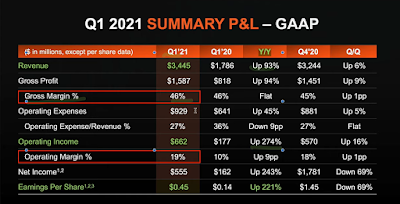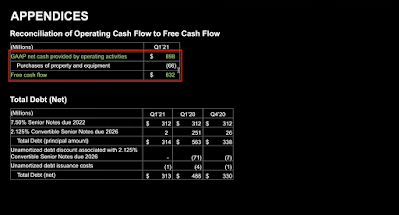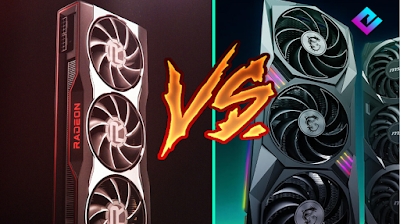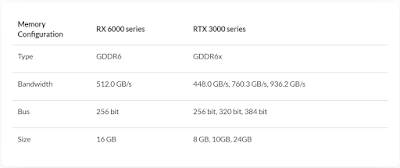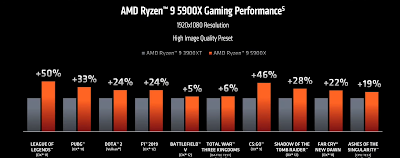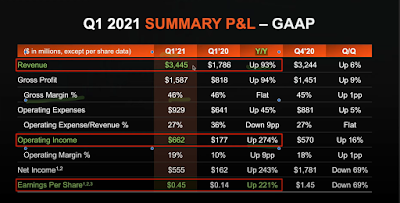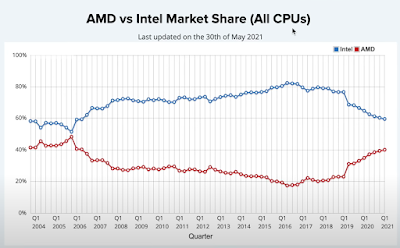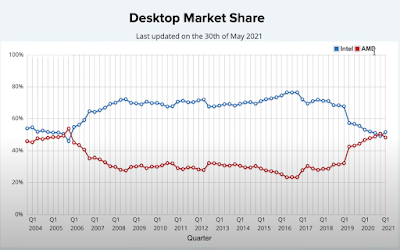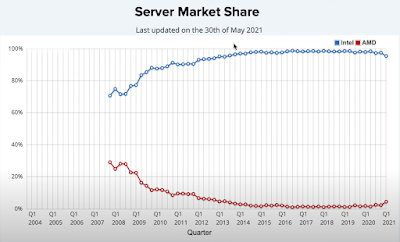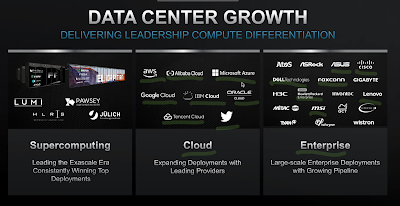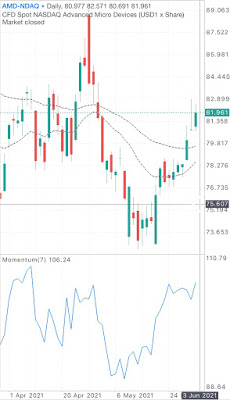In fact, if we take a look at the semi-conductor company closer, we can see that the secular growth has started its run from as early as in 2018, where the company gains 79.6% and then a further 148.1% in 2019. The unprecedented Covid-19 situation we have right now accelerates the demand we have towards particular sectors such as gaming and Internet of Things (IOT) – which begs for faster and more efficient chips processor to accommodate for these things.
Let’s first take a look at what is the business model that makes this a strong company.
The company earns revenue mainly from selling high-performance CPUs and GPUs used in gaming processors, content creators, professionals, gaming consoles such as PS5 and Xbox and data centers.
While the company once used to manufacture its own chips, the company no longer owns its own foundry and chooses to design its own chips and outsource its manufacture of the chips mainly to TSMC (Taiwan Semi-Conductor Company), the largest semi-conductor foundry in the world.
This works well to their advantage as the business model is much less capital intensive and they can focus on the research design and deliveries to their customers. For example, their NM processors are more advanced and efficient than Intel’s top end processors and this results in increased demand and pricing power. Because of this, you can see that their profit margins and free cash flow generation has improved considerably over time.
Below is a snapshot of their most recent Q1 2021 results which shows a much improved operating margin and free cash flow generating capability.
AMD’s Radeon RX 6000 Series graphics cards, featuring the breakthrough AMD RDNA 2 architecture is engineered for ultra high performance and resolution – one that competes very closely with NVIDIA’s top end GeForce RTX 3000 series.
In fact, if you compare the competitiveness of the two processors in terms of both performance and pricing, they are neck to neck with one another. Browsing through various forums, it appears that Nvidia’s slight advantage is mainly in the deep learning super sampling (DLSS), which refers to an anti-aliasing method that smooths the jagged edges that show up on the rendered graphics. This allows them to train A.I models with high-resolution scans.
The gamers can probably attest better to this than me.
In the recent Q1 2021 results, AMD’s revenue grew by as much as 93% while operating income grew by 274% due to the higher margin. Earnings per share (EPS) grew to $0.45 per quarter, which if we annualized them at nil growth, we will get a full year EPS of $1.80.
This translates into a forward annualized PER of about 44x (you can expect this number to go down if they continue to grow their numbers which most likely is the case).
If we break it down into segments, you can see that the core growth is still coming in from the CPUs and GPUs, growing at 46% year on year basis and up 7% quarter on quarter. This is due to the higher demand from higher end processors used in gaming, laptops as working from home becomes the norm during the Covid-19 lockdown.
One thing which is talked less often but brought up during the recent earnings call is the demand for powerful processors used as a requirement for mining cryptocurrency which requires very powerful and energy efficient gaming processors, which are often stronger than the normal CPUs.
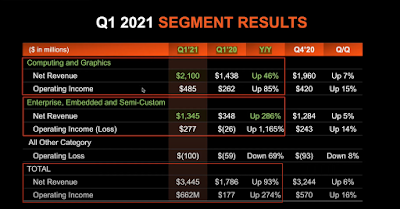 |
| Source: AMD’s Q1 2021 Results Presentation |
In the earnings transcript of the recent Q1 2021 call, CEO Dr Lisa Su said this about the company’s prospect:
” Against the backdrop of strong overall PC demand, our revenue is growing significantly faster than the market, particularly in the ultrathin, gaming and commercial segments. As a result, we believe that we gained client processor revenue share in the quarter. Our revenue share has doubled over the last two years as we have expanded in the premium products. In notebooks, we delivered our sixth straight quarter of record mobile processor revenue based on sustained demand for Ryzen 4000 series processors and the launch of our new Ryzen 5000 series processors.
Ryzen Mobile 5000 series processors revenue has ramped twice as fast as the prior generation. We expect continued growth in 2021 as the number of notebook platforms powered by our new processors is on track to increase by 50% compared to our prior generation.
In graphics, we introduced our Radeon 6700 XT desktop GPU with leadership 1440p gaming performance in March this year and are on track for the first notebooks featuring our leading-edge mobile RDNA 2 architecture to launch later this quarter. We expect Radeon 6000 Series GPU sales to grow significantly over the coming quarters as we ramp up production.”
Catalysts & Roadmap Ahead
If we take a look at the roadmap ahead for AMD, you can see that they are blasting gun ahead in all areas of CPUs, GPUs as well as Data Center – which will be key today as they are still predominantly dominated by Intel.
AMD’s next generation of 5NM chips which will be launched in 2022 is at least one generation away from Intel’s current plan ahead of the 7NM which management mentioned will be for the next 5 years .
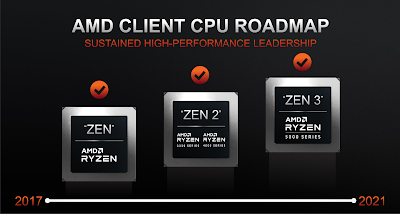 |
| AMD CPU Roadmap |
 |
| AMD GPU Roadmap |
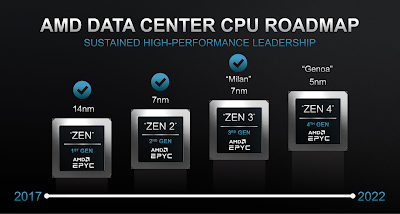 |
| AMD Data Center Roadmap |
If we take a look at the graph across all CPUs comparison, you can see that there is still plenty of room for AMD to take away Intel’s market share in terms of CPU and the shorter it takes for Intel to dominate. My guess is with Intel focusing on its own foundry now, they are looking to at least retain their market share through improving margins and more predictability of the supply.
In terms of the desktop market share, AMD’s has leapfrogged Intel’s dominance by taking it over in late 2020 and the gap looks set to be widened over the next few quarters.
Next-gen popular game consoles such as Playstation 5 and Xbox are also very lacking in supply despite the launch in November last year. These consoles are using the semi-custom as well as EPYC processor sales which is now in scarcity due to the chips supply shortage scenario.
In its latest earnings call, Dr. Lisa Su said that she expect semi-custom sales growth to remain strong in 2021 and 2022 and EPYC processor sales to double by the end of the year as Microsoft, Azure, Amazon, Google, IBM, Oracle, and Tencent significantly expand their offerings with third-gen EPYC processors.
Perhaps, the most exciting of the lot is the competition with Intel over Data Center processors where currently its 3rd Gen “Milan” processor is stronger than Intel’s top end processor due to the superior memory performance through huge caches and superior per-thread performance with specialized dedicated SKUs.
AMD’s 4th Gen “Genoa” 5NM processor is only going to take that market share even much bigger and it will be interesting to see the graph moves exponentially over the next few years.
Below are some of the cloud and enterprise customers that are already using AMD’s processors for server. These include big brand names such as AWS, Alibaba Cloud, Google Cloud, Microsoft Azure, Oracle.
Risks
While the growth in a large TAM is obvious, there are some risks to the company that we have to watch out for.
One of them in particular is the increasing competition from Intel and Nvidia in the CPU market and GPU market (mainly Nvidia).
Already earlier, I mentioned about the competition between the AMD’s Radeon RX 6000 graphics card which comes neck to neck with Nvidia’s GeForce RTX 3000 series. With Nvidia set to release its GeForce RTX 4000 series sometime in 2022, it looks like the competition between AMD and Nvidia will be very hot.
In the CPU competition front, Intel has also announced that it will spend up to $20b capex on building its own foundry in order to manufacture their own chips. This will result in more predictability of supply and can cater better to production, which is likely result in higher margins.
From the product front, Intel is also planning to release its 12th Gen Alder Lake chip which looks to give AMD’s Ryzen 5000 series processors a good run for money.
The second risk for the semi-conductor company is coming from a global chip shortage scenario.
AMD is currently dependent on TSMC to manufacture its 7NM chips and a global shortage of this will make it liable to short of supply to meet the rising demand of the customers.
Having said that, this shortage is not just a risk to the semi-conductor companies but pretty much every connected industries such as automotive, gaming, mobile, and Internet of Things.
The third risk is there may be a reliant on ARM based processors for CPUs which companies like Apple and Samsung has now decided to design on its own. For example, in late 2020, Apple announced that it will design its own chips for its new laptops and desktops using the 5NM and are going away with processors from Intel. This will eventually take market share away from both Intel and AMD and may provide a risk of entrance from new players.
Valuation
We will evaluate AMD’s valuation based on its discounted cashflow using both the cashflow and exit multiple.
AMD’s current debt value on the books is at $330m, so we’ll deduct this off from our terminal cashflow calculation in deriving at our intrinsic value for conservative purpose. We have not taken in the cash balance on the books worth $1.76b.
2020Actual cashflow number also contains the last 12 months trailing from Q2 2020 to Q1 2021 (latest result).
 |
| Source: Actual working from 3Fs compilation |
Worst Case Scenario
For our worst case scenario, we assume a terminal growth rate of 30%, which we’ve pegged the same level to the capex to arrive at the underlying unlevered free cash flow.
The terminal value is then substracted by the net debt of $330m for conservativeness before we discount it to the net present value of today’s price.
WACC sensitivity rate used throughout is leveled across from 8-10% for reference, but a middle of 9% is likely more sensible.
Different cashflow multiple of 15x, 20x and 25x is tabled consistently across the three scenarios in order to arrive at the same conclusion throughout.
Based on the 30% growth rate, WACC of 9% and a cashflow multiple of 20x, we arrive at the intrinsic value of $80.42, which is slightly than the current market value of around $82.
Do note that this is on a conservative run-rate, given on Q1 2021 alone FCF has grown by over 108.2% year on year and 73.3% even on a quarter on quarter basis.
 |
| Source: Actual working from 3Fs compilation |
Base Case Scenario
For our base case scenario, we assume a scenario of 40% growth rate throughout which is likely more probable the case.
This growth rate makes sense given that we are currently still in the midst of a secular growth and chip shortage and is likely to dominate the industry over the next few years. Also, there is plenty of room for AMD to steal more market share from Intel, especially with regards to the data center.
The same WACC and cashflow multiple sensitivity are used throughout to arrive at the same conclusion thereabout.
Based on the 40% growth rate, WACC of 9% and a cashflow multiple of 20x, we arrive at the intrinsic value of $114.63, which is about 39% upside from today current price.
 |
| Source: Actual working from 3Fs compilation |
Best Case Scenario
The best case scenario assumes a strong growth of 50% over the next 3 years and then subsequently taper off to 40% and then 30% the following year.
I think that even at this scenario, there is a good likelihood it may play out given the product roadmap on the GPU that AMD will launch its new NDNA3 or “RX3” to compete with Nvidia’s upcoming launch of the RTX 4000 series which will also likely launch in 2022.
From a data center CPU roadmap, the 5NM “Genoa” is likely going to see the biggest steal of the revenue market share from Intel.
The same WACC and cashflow multiple sensitivity are used throughout to arrive at the same conclusion thereabout.
Based on the abovementioned growth of 50% for the next three years, 40% and then 30% the following year, WACC of 9% and a cashflow multiple of 20x, we arrive at the intrinsic value of $131.43, which is about 59% upside from today current price.
 |
| Source: Actual working from 3Fs compilation |
Blended Average:
Next, we assign a probability of likelihood to all the three scenario – with 10% attributed to the worst case scenario, 50% attributed to the base case scenario and 40% attributed to the best case scenario.
The resulted blended intrinsic value came up to 10% x $80.42 + 50% x $114.63 + 40% x $131.43 = $117.9.
Technical Analysis:
From a chart perspective, the previous support of around $76-$77 doesn’t break so we should expect this to hold over the next few terms. It hasn’t had as much volume yet in terms of buying as Nvidia since it announces its plan for a stock split.
7-days momentum is strong and is align with the overall market sentiment in the past recent days.
If I were looking to enter, I’d probably prefer for it to test and retrace back to the MA20 and MA50 support before entering.

